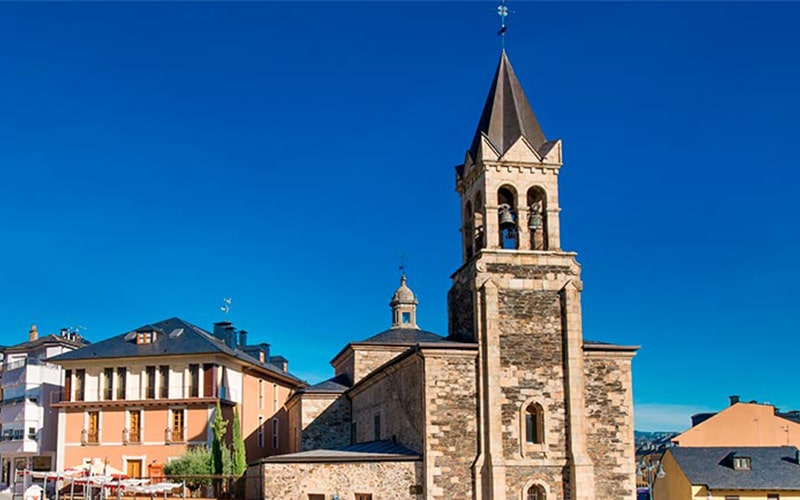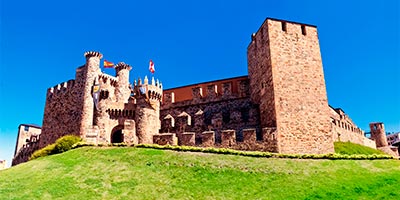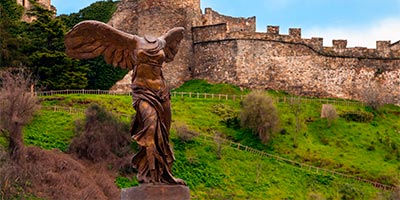The villa looking out over the river Sil got its name from the bridge that was built for pilgrims, expanded over the years at the foot of the great Templar castle, hotly contested in the fifteenth century by the turbulent Count de Lemos.

The villa looking out over the river Sil got its name from the bridge that was built for pilgrims, expanded over the years at the foot of the great Templar castle, hotly contested in the fifteenth century by the turbulent Count de Lemos.
The visit to the castle, basilica and other selected locations in paragraph Attractions in Ponferrada can be done in half a day. In the afternoon we recommend a trip south along backroads to the “Valley of Silence” and the beautiful village of Peñalba de Santiago; from there you can head up towards Mare or the ski resort of El Morredero. Another option is to go to unusual landscape of Las Médulas, where you can make multiple routes. A third alternative is to continue on the highway to the northwest and spend hours scouring Villafranca del Bierzo. In this town you can eat very well, to know their local dishes and book Sleeping offer to stay and eat in Ponferrada page.
The Romans built in the late first century. C. a citadel that was taken by the Swabians, later by the Visigoths and finally by Muslims; although there is no documentary evidence of such attacks. The rise of the Camino de Santiago and the difficulty fording the river Sil motivated the bishop of Astorga in 1082 to build a bridge, Pons ferrata, reinforced with iron railings. From here originates the name of the town.
King Ferdinand II surrendered the town to the Order of the Temple in 1178, granting a charter two years later. Knights Templar fortresses raised in this and other points of Bierzo in the early fourteenth century; Ponferrada chose the site of the ancient Roman citadel. They promoted the walls around the villa, which grows with distance from the border and traffic of pilgrims. In 1196 King Alfonso IX of Leon withdrew the lordship of the town to the Templars, returning it fifteen years later.
When suppressing knighthood in 1312, the Grand Master of Castile gave the manor of Ponferrada to Infante Don Felipe, brother of King Ferdinand IV. Crown property in 1340, the manor was delivered to the butler of the king, Pedro Fernandez de Castro; this was attributed to the construction of the “Old Castle”. In 1374 the lordship returned to the royal heritage, which yielded in 1440 the First Conde de Lemos; it gave its current configuration to the fortress. The emergence of a dispute over the inheritance of the First Conde, the decision of the Catholic Monarchs was not respected by the Conde II, who in 1485 besieged and conquered the fortress. The army of the King, after a siege in which artillery was used, conquered the fort in the summer of 1486. The Queen entered the village to the Crown appointing a magistrate to rule; He founded the Hospital of the Queen in 1489. In August 1506 the Conde de Lemos retook the castle by surprise.
In 1558 the Third Marquess of Villafranca del Bierzo purchased the Crown fortress in exchange for 1.3 million coppers.

In 1808, the Ponferrada Board of Defense was founded, and it played an important role in the organization of the French resistance during the war. The villa would be conquered by the French in January 1809 and then abandoned; so that the strength was not employed by them, in 1811 the Patriots flying the castle, which is useless. In 1848 the City auction ashlar stones of the castle, which is progressively dismantled. To get space in order to prepare a sports field, in 1923 the remaining walls were blown up with explosives.
The arrival of the railroad in the nineteenth determined with the beginning of the industrial boom, strengthened by installing a steel plant in 1918 and the power plant Compostilla in the forties. This rapid industrialization gave rise to the new city to host the alluvium and population increase, confirming it as head of its district and commercial and industrial center.
The tour begins through the old town, where stands the Castle of the Knights Templar, a grand convent strength of nearly one hectare, with a polygonal structure built during the XIII century. It maintains extensive canvases, battlements, defensive loopholes in three levels and a dramatic entrance among beautiful-towers leading to the Plaza de Armas and other agencies.
At the foot of the castle at Temple Square is the Baroque Church of San Andrés. It is the Christ of Fortaleza, moved there from this in the nineteenth century; there are also guarding the steps used in the processions of Holy Week.
Passing through Calle Gil y Carrasco, you can admire noble mansions as the House of Shields, eighteenth century building that for some years hosts the Radio Museum. This initiative berciano journalist Luis del Olmo traces the history of radio in Spain, its radio broadcasting systems and equipment.
This street leads to the square where the Basilica of Our Lady of the Oak is located, temple of Renaissance style of the late sixteenth century topped by a tower of the seventeenth century. It is dedicated to the patron saint whose image Bierzo found a Knight Templar in the hollow of an oak after a long journey. The interior was renovated in the eighteenth century, the addition of an alcove with oval dome that houses a seventeenth-century altarpiece with interesting sculptures, paintings and goldsmith works; presiding the altarpiece is the Virgen de la Encina, also called “Morenica”.
From this square starts the Clock Street – next to the tower of the XVI century, built next to the gates of the Wall- is one of the most picturesque corners of Ponferrada; on that street overlook the Convent of the Conception, the Palace of the Counts of Toreno and the former Real Jail 1565. The latter building houses the Museo del Bierzo with objects dating from the Paleolithic to the present. The street leads to the Plaza de las Eras, where the Town Hall of 1692 is, Baroque and rectangular towers topped by spiers on its flanks.
Other attractions to see in Ponferrada are the Railway Museum, which preserves beautiful examples of locomotives, and the Museum of the Brotherhoods, which is based in the ancient Church of San Antonio and exhibits the artistic heritage of Easter Ponferradina.
Moreover, in line with its industrial history, Avenida de la Libertad is the ENE, National Museum of Energy, ambitious state museum park character. Jan Thermal includes plants of old power station with three visitable areas (Muelle de Carbones, ship boilers and turbines ships). Opening outstanding areas will be located in the old center of Compostilla (Jan. Central) and then Jan Bosque aims to be a peninsular ecosystems reproductions of the era of coal mining.
On the outskirts worth visiting the Santo Tomás de las Ollas, a Mozarabic construction of the tenth century; It highlights the original chapel of his head by the vault that support horseshoe arches.
South, after crossing the bridge over the Boeza is Otero Ponferrada (which has been assimilated as a neighborhood of the town) you arrive at the Church of Santa Maria de Vizbayo, considered one of the oldest Romanesque buildings of the eleventh century.


42º 32’ 46’’ N, 6º 35’ 27’’ W
León 102 km, Madrid 397 km
512 m
68 121 (2013)